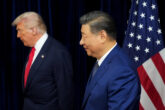November 14, 2023
U.S.-China Competition and the Race to 6G
This article was originally published in Italian by Formiche, this English version was provided by the author.
The country that leads the development and deployment of 6G—the next generation of wireless telecommunications—will control critical infrastructure that is integral to global economic competitiveness, national security, and the functioning of society. 6G is thus a key battleground of U.S.-China technology competition. Though 6G is not expected to be commercially available until 2030, China’s dominance of fifth-generation networks highlights the importance of planning and early market entry. The United States must act now to establish 6G leadership and ensure the development of secure and resilient networks.
6G aims to unlock faster, more reliable, and more sustainable communications capabilities. 6G promises to connect significantly more devices to the internet at higher speeds and with lower latency than 5G networks. These advances will allow for dependable communications networks that can connect devices simultaneously and support a range of novel technologies, such as virtual and augmented reality, robotics, and autonomous vehicles.
While 5G focused on advancing the Internet of Things, 6G will enable a more digitally immersive world that can even mirror reality. For example, 6G will enable near-real time human-to-human, human-to-machine, and machine-to-machine communications, opening a range of new capabilities, products, and services across multiple industries, from agriculture and healthcare to transportation and defense. 6G will enable economic and technological competitiveness in the 21st century, and the first country to operationalize it will gain an upper hand in establishing a favorable market position and setting standards for the design and use of 6G devices. As with 5G, China has jumped to an early lead in the 6G race.
China views telecommunications as central to its geopolitical and strategic objectives. Multiple strategy documents—such as the 14th Five-Year Plan for National Informatization—rank 6G among the government’s top priorities. China aims to dominate the development and rollout of 6G infrastructure, just as it did in 5G, where Chinese firms maintain 70 percent of the world’s base stations and 80 percent of 5G connected devices.
China’s approach to 6G mirrors its approach to 5G. The Chinese government is leveraging subsidies, credit facilities, tax breaks, and related forms of state support to boost domestic equipment manufacturing capacity and position Chinese firms to gain an early 6G market advantage. China is also investing heavily in the enabling technologies that form the backbone of 6G infrastructure, such as legacy chips and artificial intelligence, to reduce dependencies on foreign suppliers and secure a competitive edge across the entire 6G supply chain. Simultaneously, China is increasing its participation in international fora to gain influence over standard-setting processes and make Chinese telecommunications companies the preferred 6G providers around the world.
China views telecommunications as central to its geopolitical and strategic objectives.
A China-led 6G ecosystem poses several challenges for the United States. U.S. 6G vendors may struggle to compete internationally with state-backed Chinese firms that can offer lower prices, invest in high-risk projects, and have more experience operating in remote areas. Further, countries that integrate Chinese 6G technologies into their networks could be vulnerable to espionage, intellectual property theft, or censorship. Widespread global adoption of Chinese technologies could force the United States to rethink its alliance networks and information-sharing mechanisms.
China’s 6G ambitions carry implications for U.S. national security and defense as well. Beyond reaping the economic benefits of 6G, China also aims to lead in military applications of the technology. In January 2022, Chinese researchers reportedly developed a 6G laser device that can detect stealth aircraft, enhance high-speed space communications, and bolster China’s hypersonic missile program. China could also leverage 6G to improve its surveillance and reconnaissance capabilities, augment military personnel training, or streamline command and control processes. In short, China could employ its 6G capabilities to gain a significant military advantage should conflict with the United States occur.
The United States cannot afford to cede the lead in 6G. To boost American competitiveness in this critical technology area, U.S. policymakers should craft a comprehensive 6G strategy, expand 6G-focused research and development funding, foster mutually beneficial relationships with private industry, and partner with allies to develop best practices and principles for 6G security and implementation. China is moving fast to recreate the conditions that enabled its 5G dominance. The onus is on U.S. policymakers to absorb lessons learned from the 5G race and drive a new approach to 6G that optimizes performance, accessibility, and security.
Read the full article and more from Formiche.
More from CNAS
-
Transatlantic Security / Technology & National Security
Look Before We Leap on Artificial IntelligenceThis article was originally published on The Dispatch. A debate about the role that artificial intelligence should and will play in society, and how it will affect humanity fo...
By Jon B. Wolfsthal
-
Technology & National Security
Caleb Withers on the Cybersecurity Frontier in the Age of AICaleb Withers, research associate at the Center for a New American Security, joins Kevin Frazier, the AI Innovation and Law Fellow at the University of Texas School of Law and...
By Caleb Withers
-
Technology & National Security
Prepared, Not ParalyzedExecutive Summary The Trump administration has embraced a pro-innovation approach to artificial intelligence (AI) policy. Its AI Action Plan, released July 2025, underscores t...
By Janet Egan, Spencer Michaels & Caleb Withers
-
Indo-Pacific Security / Technology & National Security
Sharper: Tech + ChinaRecent talks between President Donald Trump and Chinese Communist Party General Secretary Xi Jinping placed a spotlight on emerging technologies, from high-end chips to minera...
By Charles Horn & Sevi Silvia




